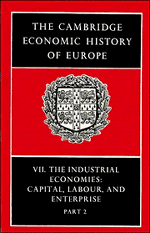CHAPTER I - Capital Formation in the United States during the Nineteenth Century
from THE UNITED STATES
Published online by Cambridge University Press: 28 March 2008
Summary
Introduction
One of the grand themes of the literature on economic development relates to the behaviour of the investment rate in the early stages of modern economic growth. Economists from Adam Smith onward have given capital formation an important role in economic growth, and a considerable literature has grown up around the notion that modernization involves a rise in the share of income invested. The American record displays a very prolonged and pronounced long-term movement in this share, a movement that has not as yet received a very full analytical treatment.
The fraction of American real net national product devoted to investment rose from an average value of perhaps 6 or 7 per cent in the first four decades of the nineteenth century, to between 10 and 12 per cent in the decades just before the Civil War, to 18–20 per cent in the decades between the Civil War and the First World War (see Table 1). This development is one of the most striking aspects of American nineteenth-century economic growth, and we have chosen it as the organizing theme of this chapter. We have brought together the evidence on the volume and composition of saving, investment, income, and the capital stock and have attempted to answer two questions: (1) What role did the dramatic increase in the investment share play in American economic development? (2) How can the increase in the share be accounted for?
- Type
- Chapter
- Information
- The Cambridge Economic History of Europe , pp. 1 - 69Publisher: Cambridge University PressPrint publication year: 1978
References
- 6
- Cited by



